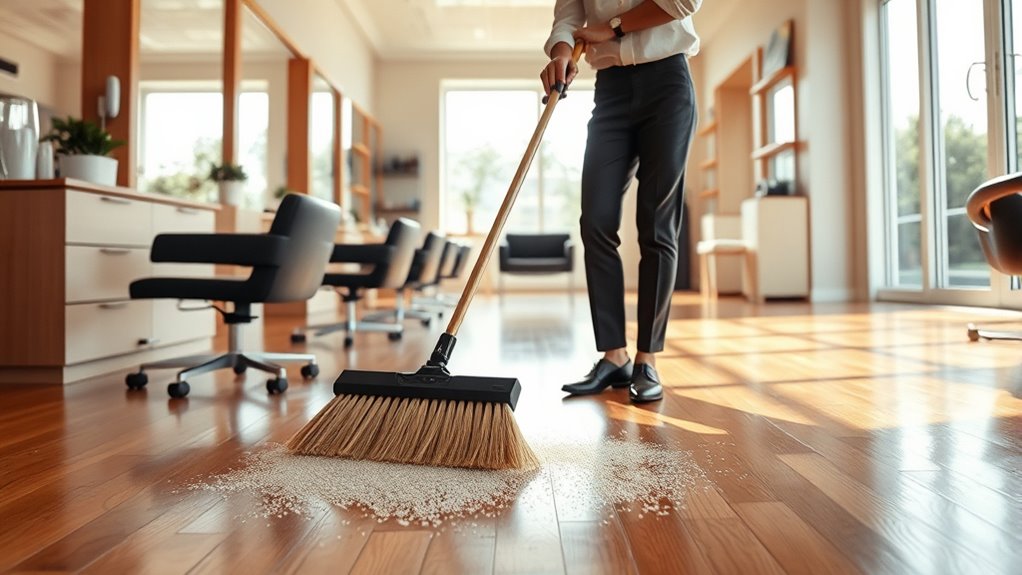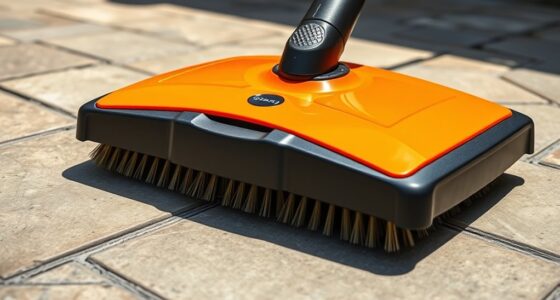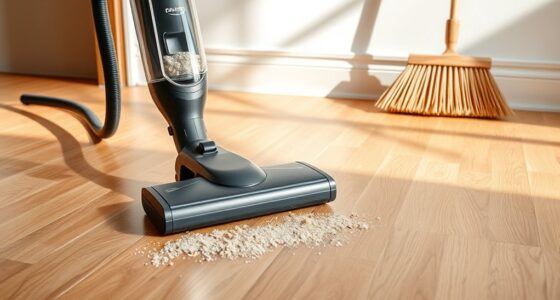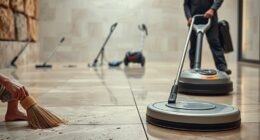To beat fine dust in salons, follow a two-pass sweeping plan. First, use damp cloths or HEPA-filtered vacuums to clean surfaces and prevent dust from becoming airborne. Next, improve air quality with purifiers that have HEPA filters, activated carbon, or UV-C sterilization. Position these devices near working areas for maximum effectiveness. Maintaining your equipment and educating staff will guarantee a healthier environment. Discover more ways to keep your salon safe and dust-free.
Key Takeaways
- Use damp cloths or HEPA vacuums during the first pass to remove surface dust and prevent airborne particles.
- Implement a second pass with air purifiers equipped with HEPA filters, activated carbon, or UV-C sterilization.
- Properly position air purification devices near styling, manicure, and drying areas for maximum effectiveness.
- Regularly maintain and replace filters and equipment to ensure optimal dust removal performance.
- Educate staff on the two-pass sweeping process to promote consistent and thorough dust control practices.

Many salons are overlooked as sources of fine dust, yet these tiny particles can pose serious health risks to both workers and clients. Fine dust from hair treatments, styling products, and nail powders can linger in the air, leading to respiratory issues, allergies, and other health problems over time. To combat this, implementing effective air purification and ventilation systems is vital. These systems help remove airborne particles, improve indoor air quality, and create a safer environment for everyone. Without proper ventilation, dust accumulates in the air, making it harder to breathe and increasing exposure levels.
Fine dust in salons poses health risks; effective purification and ventilation are essential for safety.
A two-pass sweeping plan offers a practical approach to controlling fine dust in your salon. The first pass involves thorough cleaning of surfaces and equipment using damp cloths or vacuum systems with HEPA filters. This step minimizes the amount of dust that gets stirred into the air during cleaning. The second pass focuses on the air itself. Here, you utilize air purification devices equipped with HEPA filters, activated carbon, or UV-C sterilization to capture airborne particles that linger after surface cleaning. This two-step method ensures dust is tackled both at its source and in the air, markedly reducing the overall dust levels.
Investing in high-quality air purification units is vital. These devices should be positioned strategically around your workspace—near styling stations, manicure tables, and drying areas—to maximize their effectiveness. Modern air purifiers with adjustable settings can handle different levels of dust and pollutants, providing cleaner air consistently. Additionally, improving your salon’s ventilation system ensures a steady flow of fresh air, diluting contaminants and preventing dust from settling in corners or on surfaces. Proper ventilation also helps in removing chemical fumes, which can combine with dust to create more hazardous indoor air.
Regular maintenance of your ventilation and air purification systems is key to their performance. Change filters as recommended, and ensure fans and ducts are clean and unobstructed. Educate your staff about the importance of these systems and encourage them to follow cleaning protocols diligently. By integrating a two-pass sweeping plan with reliable air purification and ventilation, you create a healthier environment that minimizes dust exposure. This proactive approach not only protects your health and that of your clients but also enhances your salon’s reputation for safety and cleanliness. In the end, addressing fine dust with these strategies results in a more inviting, safer space where everyone can focus on beauty without worrying about airborne health hazards.
Frequently Asked Questions
What Equipment Is Most Effective for Fine Dust Removal?
You should use high-efficiency particulate air (HEPA) vacuums and air purifiers designed for fine dust removal. These devices effectively trap tiny particles, improving air quality. Combine this with air quality monitoring to identify dust levels and adjust your dust containment strategies accordingly. Regularly maintaining equipment ensures peak performance, helping you create a cleaner, safer salon environment while reducing health risks from fine dust.
How Often Should Salons Perform Dust Cleaning Procedures?
You should perform dust cleaning procedures at least daily to maintain air quality standards in your salon. Regular cleaning helps prevent dust buildup and guarantees a safe environment. Use dust monitoring techniques to assess air quality regularly, and adjust your cleaning schedule accordingly. Consistent cleaning not only keeps the environment healthy but also complies with industry standards, ensuring both your clients and staff are protected from fine dust exposure.
Are There Specific Products Recommended for Dust Suppression?
You might worry about choosing the right products, but using air filtration systems and dust barriers effectively suppresses dust without harsh chemicals. Look for products with high-efficiency filters and dust-control mats to trap particles upfront. Regularly maintain and replace filters, and set up dust barriers around workstations. This proactive approach keeps dust levels low, improves air quality, and guarantees a healthier salon environment for both clients and staff.
How Can Staff Be Trained to Minimize Dust Generation?
You can train your staff through in-depth programs that focus on dust minimization techniques. Incorporate air quality monitoring to identify dust hotspots and adjust cleaning practices accordingly. Use staff training programs to teach proper sweeping methods, encouraging gentle, two-pass sweeping to reduce dust generation. Regularly update these programs to keep staff informed about best practices, ensuring a safer salon environment and better air quality for everyone.
What Are the Health Risks Associated With Fine Dust Exposure?
Are you aware of the health risks posed by fine dust exposure? Airborne particles can settle in your lungs, leading to respiratory issues like asthma, bronchitis, or even long-term lung damage. Breathing in fine dust regularly compromises your respiratory health and can cause irritation, coughing, and difficulty breathing. Protect yourself by implementing proper cleaning protocols, ensuring good ventilation, and wearing protective gear to minimize exposure and safeguard your well-being.
Conclusion
Implementing the two-pass sweeping plan effectively reduces fine dust in salons, creating a healthier environment for everyone. For instance, a salon that adopted this method saw a noticeable drop in dust levels after just a month, resulting in happier clients and staff. By consistently following this approach, you not only improve air quality but also demonstrate your commitment to safety and professionalism. Embrace the plan, and watch your salon become a cleaner, safer space for all.









